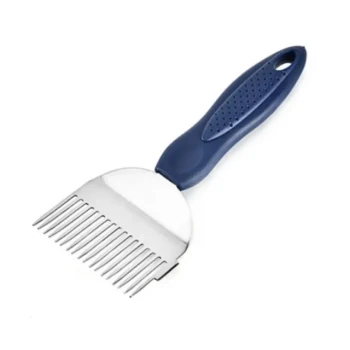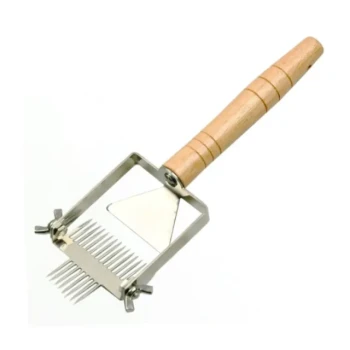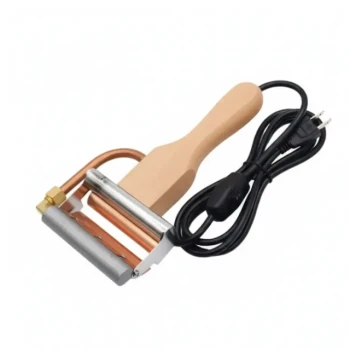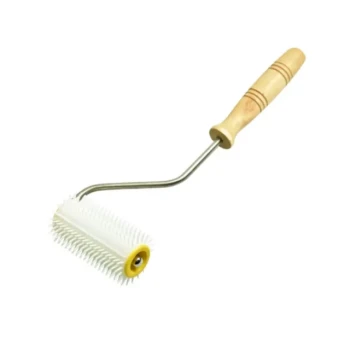Beyond the empty frame, several methods are used to support foundationless beekeeping. The most common techniques involve adding a "starter strip"—a small guide made from a 1-2 inch piece of wax foundation or a wooden popsicle stick—to the top of the frame. For beekeepers who plan to extract honey, threading wire through the frame is also a critical step to provide structural reinforcement.
The core challenge of foundationless beekeeping is guiding the bees to build straight comb within the confines of a single frame. Support methods are not meant to replace the bees' natural comb-building, but rather to provide a clear starting point and add structural integrity where needed.
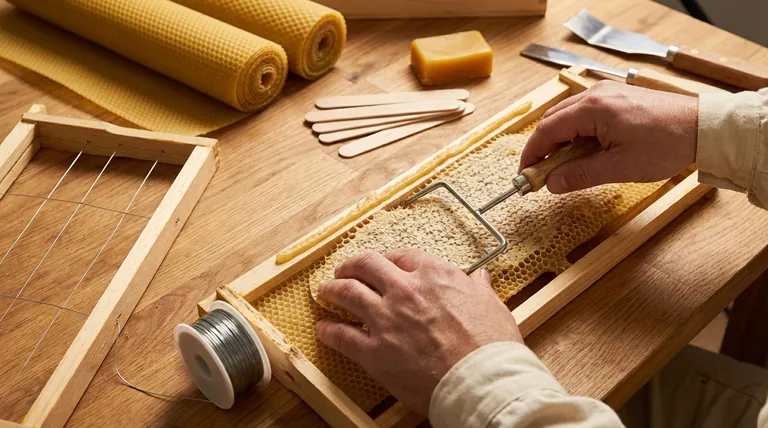
Why Foundationless Frames Need Support
The Problem of Cross Comb
Bees in a natural cavity build comb to their own logic, connecting it where they see fit. In a hive box, we need them to build straight comb within each frame for inspections and management.
Without a guide, bees will often build "cross comb," attaching a single comb across multiple frames. This makes it impossible to remove a frame without tearing and destroying the comb, killing brood, and spilling honey.
The Need for Structural Integrity
Natural beeswax comb is fragile. While it's strong enough for the bees, it can easily break under its own weight when full of honey, especially in hot weather or during hive inspections.
This fragility is a major issue for beekeepers who use centrifugal extractors, as the force can easily shatter the comb.
Key Support Methods Explained
Using Starter Strips as a Guide
A starter strip is a simple, narrow guide placed at the very top of the frame where you want the bees to begin drawing their comb.
You can use a 1- to 2-inch strip of wax foundation. This gives the bees a literal foundation of beeswax to follow, which they readily accept.
Alternatively, a simple wood popsicle stick or a triangular piece of molding can be glued into the groove of the top bar. This creates a sharp, defined edge that bees instinctively use as a starting line for their comb.
Adding Wire for Reinforcement
Wiring is a method focused purely on structural support. It does little to guide the initial placement of the comb but is essential for preventing "blowouts" in honey extractors.
This process involves threading thin, specialized wire horizontally through holes in the frame's side bars. It is more labor-intensive but provides a rigid internal skeleton for the delicate wax comb.
Understanding the Trade-offs
Labor vs. Durability
Starter strips are quick and easy to install but offer minimal structural help. They are primarily for guiding the bees.
Wiring is time-consuming but provides the reinforcement necessary for mechanical honey extraction. For those who only practice crush-and-strain extraction or sell cut comb, wiring is often unnecessary.
Foundationless vs. Full Foundation
Foundationless frames allow bees to build their own natural cell sizes and produce pure beeswax comb, which is ideal for selling cut comb honey. However, it requires more vigilance to prevent cross comb.
Using full plastic or wax foundation provides maximum structure and encourages bees to build quickly and straight. However, it introduces a pre-determined cell size and, in the case of plastic, a foreign material into the hive.
The Ongoing Need for Monitoring
Even with starter strips, you must check new foundationless frames frequently. If the bees begin building comb at an angle, you must correct it immediately while the comb is small and soft. This is the primary "cost" of foundationless beekeeping: it requires more hands-on management in the beginning.
How to Apply This to Your Goal
Choosing the right support comes down to your primary objective as a beekeeper.
- If your primary focus is selling cut comb honey or natural beekeeping: A simple wax or wood starter strip is the ideal method to guide straight comb construction.
- If your primary focus is extracting honey with a centrifuge: Wiring your foundationless frames is essential to prevent the comb from breaking apart during extraction.
- If your primary focus is maximum simplicity and minimal monitoring: Using full sheets of plastic or wired wax foundation is a more straightforward approach than managing foundationless frames.
Ultimately, selecting the right support method empowers you to successfully balance the benefits of natural comb with the practical needs of modern beekeeping.
Summary Table:
| Support Method | Primary Purpose | Best For Beekeepers Who... |
|---|---|---|
| Starter Strips (Wax/Wood) | Guides bees to build straight comb | Sell cut comb honey or practice natural beekeeping |
| Wiring | Adds structural integrity for extraction | Use centrifugal honey extractors |
| Full Foundation (Wax/Plastic) | Maximum structure and simplicity | Prioritize ease and minimal monitoring |
Ready to build stronger, more productive hives?
At HONESTBEE, we supply commercial apiaries and beekeeping equipment distributors with the high-quality supplies needed for success. Whether you're managing foundationless frames or standard setups, our wholesale-focused operations provide the durable equipment—from frames and wiring tools to extractors—that your business depends on.
Let's discuss how we can support your beekeeping goals. Contact our team today for wholesale pricing and expert advice.
Visual Guide
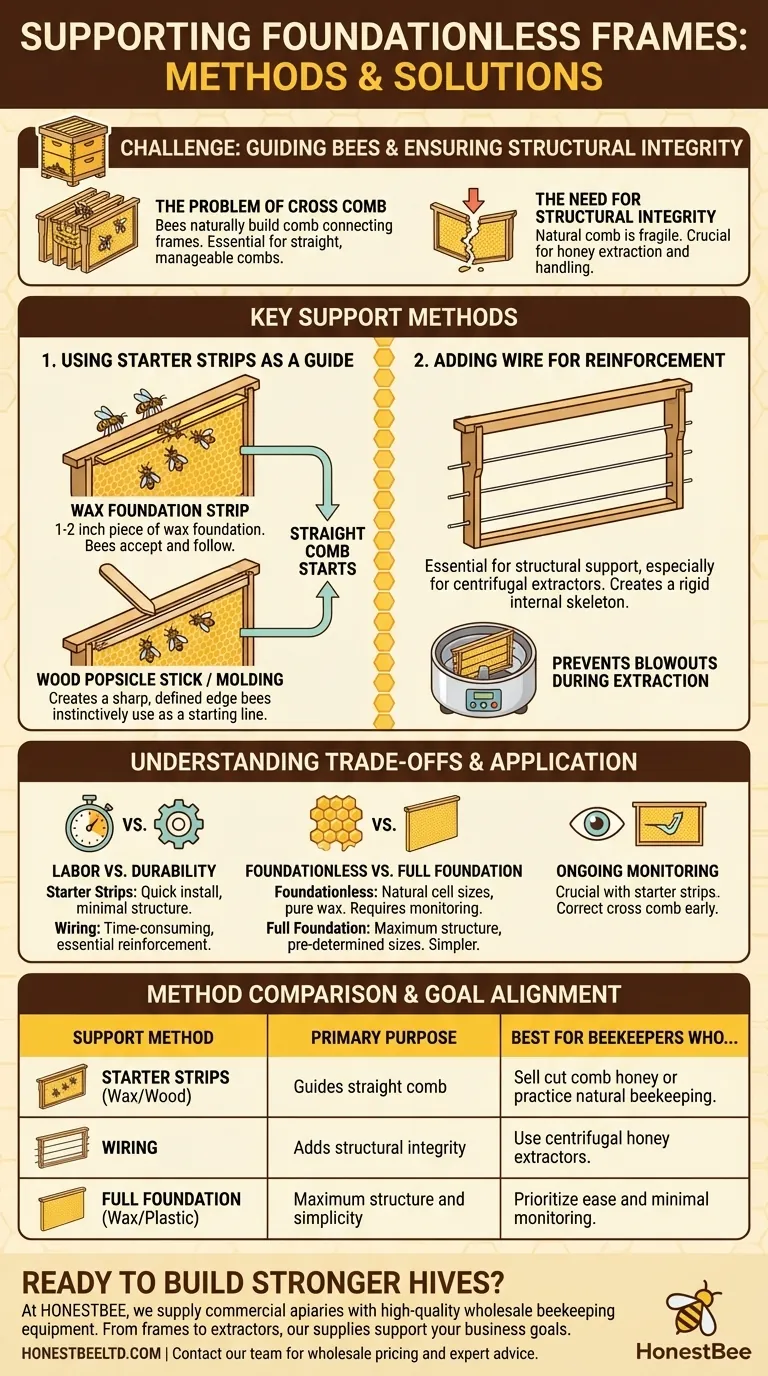
Related Products
- Professional Frame Comb Fork and Lifter for Efficient Handling
- Professional Dual-End Stainless Steel Hive Tool for Beekeeping
- Professional Multi-Function Stainless Steel Hive Tool
- HONESTBEE Advanced Ergonomic Stainless Steel Hive Tool for Beekeeping
- Professional Frame Preparation: The HONESTBEE Electric Wire Embedder
People Also Ask
- What are the features of a regular hive tool? The Essential Multi-Tool for Every Beekeeper
- What are the parts of a hive tool? Master Your Hive Inspections with the Right Tool
- What precautions should be taken when using a sharpened hive tool? Maximize Efficiency While Staying Safe
- What products pair well with Frame Grips for beekeeping? Build Your Complete Hive Inspection Toolkit
- What are the considerations when assembling unassembled frames for beehives? Ensure Hive Integrity and Honey Harvest Success






